I didn't take too many photos, but one of the snow leopards was asleep on its back, so I took some of that. My arms are kind of short due to the fact I am tinycat so it's hard to take decent photos. I also tried to get lemur photos but they were all sitting in the sun so they were just patches of glare.
If you click on the photos, you can see some pretty good detail on the dear cat.
 Anyway, this isn't really a post on the zoo. It's a post about cats. Not another cat fact sheet - this is a post about all the endangered cat species in the world - and there are lots. I live well within the knowledge that nearly no one will read this post, but it burned nearly six hours of time up.
Anyway, this isn't really a post on the zoo. It's a post about cats. Not another cat fact sheet - this is a post about all the endangered cat species in the world - and there are lots. I live well within the knowledge that nearly no one will read this post, but it burned nearly six hours of time up.If you know all this definition crap, I have helpfully put a header on the main point of the post.
Here is the Wiki definition of Feliformia, links intact so you can click through for learnings.
"The Feliformia ("cat-like" carnivorans, also Feloidea) are a suborder within the order Carnivora and includes cats (large and small), hyenas, mongooses, civets and related taxa. The other suborder of Carnivora is Caniformia ("dog-like" carnivorans)."With beautiful, beautiful encyclopedic defitions out of the way, I am of course going to talk about feliformia. Caniformia can wait for another day. As the definition states, it is a large suborder within Carnivora. (Fun fact: The southern elephant seal is the biggest member of Carnivora. Yes, even bigger than polar bears. Here is their wiki. Note the sexual dysmorphia between the bull and cow. Poor ladies, I know that feel.) I will be making a series of posts on feliformia.
More specifically than just feliforms for the next few posts, however, I will be talking about felidae - both big, and small, cats. Can we break for a kitty picture? Yes? Yes we...? Yes we can. Okay. Break for a kitty picture.
 |
| This has been: a kitty picture. saws: wikipedia Carnviora page |
 |
| European Wildcat, saws: wikipedia. Felis Silvestris. Not endangered, but very cute. |
What is interesting, however, is the fact that while most species of cats are considered solitary, there are so many exceptions to this that it always seemed a little strange to rule them so strictly. While you get some dogs that don't like other dogs, and some cats that don't like other cats, they are social animals - but while many cats, big and small, are thought of as "solitary", the overwhelming number of "but some individuals have been observed" should change the classification to "semi-social". But that is my opinion, not a university student or anything.
This post will be covering endangered felidae and the threats facing feral and stray domestic cats.
The Main Article
Of the feline family, the small cats, there are 34 distinct species (according to my sawses, I could be wrong however, and have miscounted. Regardless, there are 41 known felids, including pantherinae). They range from small (the sand cat) to the large (the cheetah, and puma). Most people have never heard of most of these species before, and little to no conservation effort is being made in the public arena outside of specialist groups. So let's start with the most endangered feline.
CRITICALLY ENDANGERED
 |
| pictures-of-cats.org - best website ever? |
The most critically endangered cat, native to Southern Europe and the Iberian Peninsula. Like other lynx, they have tall ears ending with fur tufts. They have leopardlike spots and a short tail, no longer than a foot long (which is short, on a feline that is over a metre long). Males average 12.9kg, with a maximum of nearly 25kg, whereas the females average around 9kg. They are vulnerable to myxomatosis, which it may catch from its main prey of rabbits. Threats to this species include habitat loss, poisoning, road kills, and poaching, however much of its decline in the last decade is caused by myxomatosis.
Iriomote Cat
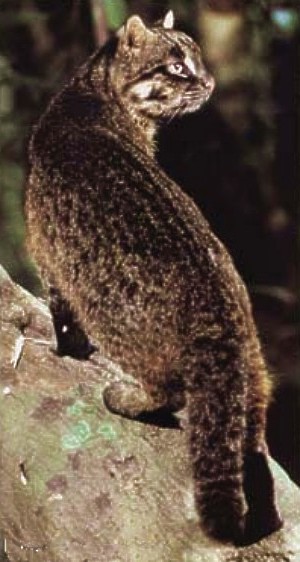 |
| servals.org |
They have a short, low body suited to a foraging predator. Its fur is dark to medium brown. It is a small cat, about the size of a domesticated feline. Its tail is relatively short. Its diet consists of small mammals, birds and reptiles. Its main threat is human industrialisation.
ENDANGERED
 |
| Cloudedleopard.org |
A wild cat endemic to Borneo. The bay cat is very rare, very shy and very secretive. Wikipedia notes that a trap camera study from 2003 to 2006, with a total of 5, 034 combined camera hours, yeilded one photograph of the animal. Too few species have been studied for size and weight estimate, gathered information puts them at upwards of 40cm long with a foot-or-so-long tail. They were once thought to be a kitten of the Asian Golden Cat. Their tail is reddish with a white stripe down the underside like a stoat or marten. Its main threats are encroaching humans, deforestation and palm oil harvesting.
Flat-Headed Cat
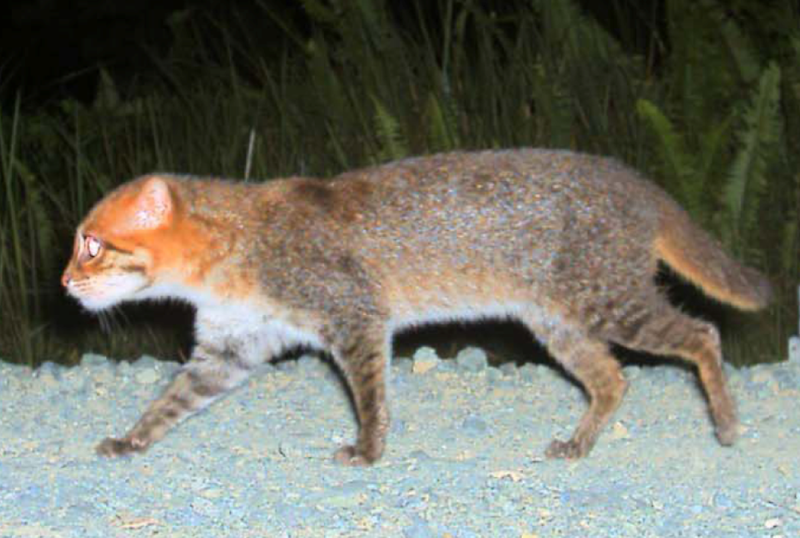 |
| Wikipedia |
Andean Mountain Cat
 |
| Wikipedia |
The Fishing Cat
 |
| Taronga Zoo's fishing cat. saws: wikipedia |
VULNERABLE
 |
| Wikipedia |
Also known as the Chinese Desert Cat, it is a small wildcat from...China, believe it or not. It resembles the European Wildcat, except for its fur colour, which is a sandish grey colour. Its ears and tail are tipped with black, with some dark rings present on the tail and back legs. It also has horizontal lines on its face, more visible in some individuals than others. They range from 69-84cm long, with a tail between 29-41cm. Their main diet consist of pikas, rodents and birds. Their decline is caused by the poisoning of pikas, their main food source, which either poisons the cats or causes withdrawral of their food.
Black-Footed Cat
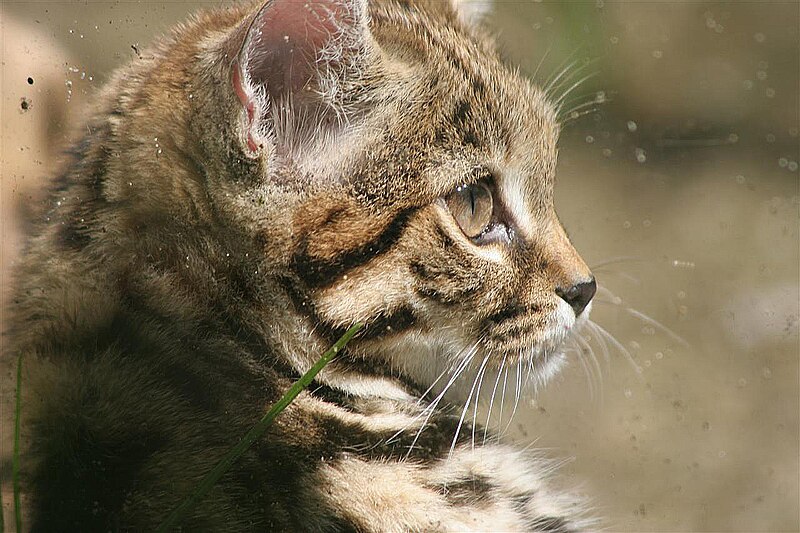 |
| Wikipedia |
Oncilla
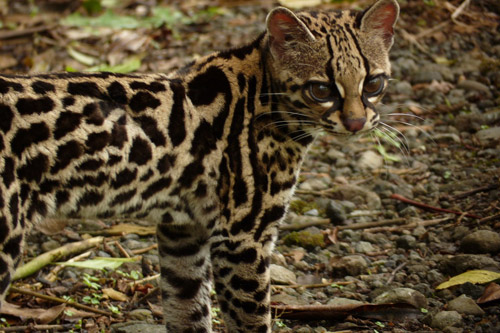 |
| Felinest.com |
Rusty-spotted Cat
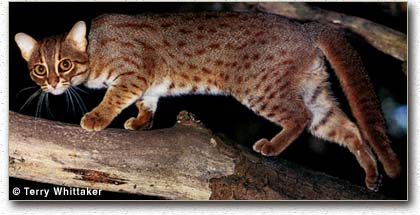 |
| animalinfo.org |
There are two subspecies: one in India, one in Sri Lanka. While originally thought to only inhabit the south of India, studies show they are found all through the country. At birth, its kittens (usually one or two) have rows of black spots, and no more than 77g. The threats facing this unique animal are the spreading cultivation and industrialisation of both of the countries, mainly due to western influence and unstable economic growth. Anecdotal evidence shows they make very affectionate pets. The Animal Diversity website says this about the species: "When taken captive, the rusty-spotted cat is a very affectionate, playful, and expressive cat, that longs for the company and attention of its owner."
Marbled Cat
The last cat on our list is a small cat from Asia and South-East Asia. It is closely related to both the Bay Cat and the Asian Golden Cat. Similarly sized to the domestic cat, it has a tail with thick fur, which may be longer than the body. It does not weigh more than 5kg, as it spends most of its life in trees. With banded, blotchy fur like marble, it is similar in appearance to clouded leopards. It has spots on its legs, head and underside, with dark bands on its long tail. It measures between 45cm and 62cm, with a tail as long as 55cm.
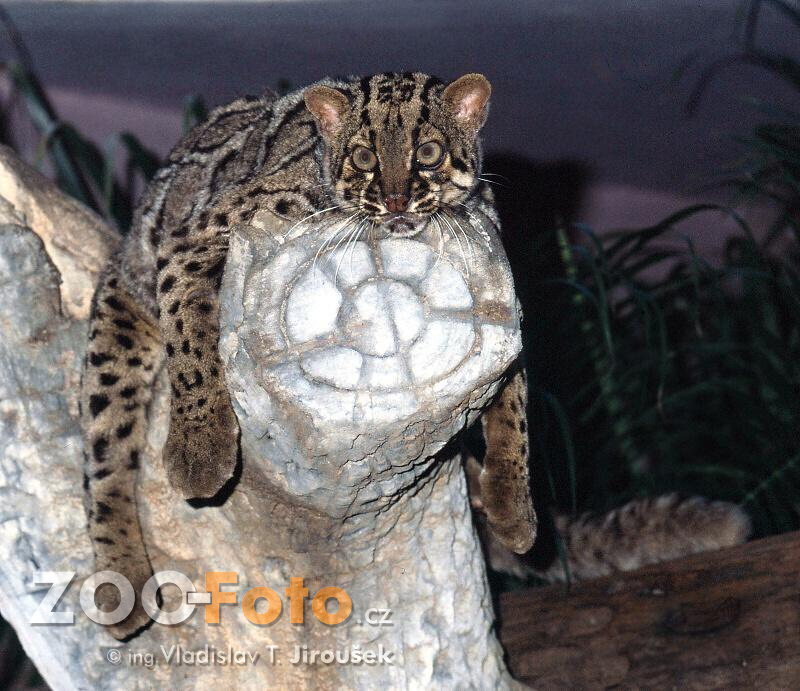 |
| Zoo-Foto.cz - I thought this was a lovely photo! |
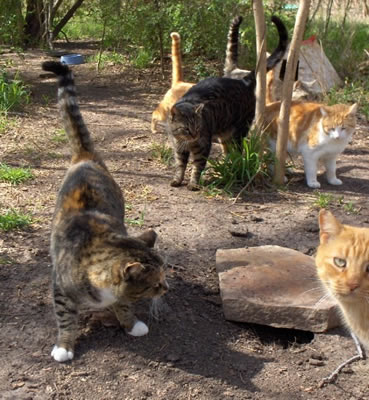 |
| Wordpress. |
Feral cats are domestic cats that have reverted to a wild state, or born in such conditions. They are distinct from stray cats in that strays show little to no agression towards humans, and can easily be caught and rehomed with humans. There are also semi-feral cats, such as farm cats. Feral cats have little to no positive interactions with humans, and reguard them with fear, suspicion or aggression. Every year, hundreds of thousands of feral cats are killed by humans, whether accidentally, or on purpose. They are likely to die very young, from fighting, disease, poison and over-breeding.
Feral cats pose a danger to wildlife, and here in Australia are often poisoned as a nuisance and as pests, and animal abuse with cats in rural towns is considered "boys will be boys", and no one is punished for the heinous torture of cats and kittens. Studies show, however, that the most effective way of controlling populations is the "trap-neuter-release" method, where ferals are trapped, sterilised, an ear tipped to mark their sterilisation and are released back into their environments. More information on the lives of feral cats can be found here.
 |
| Wikipedia. |
Helping feral cats, and wild cats around the world, is easy. Donate your money, or better yet, your time to organisations that help stray and feral cats. Organisations like the Big Cat Rescue in Tampa, Florida dedicate themselves to helping wildcats and big cats in private zoos.
More ways to help feral cats are to try and give time to cat shelters, and foster cats and kittens until they can be adopted. Spreading awareness of the plight of cats, domestic and wild, worldwide will help save millions of individuals. To help protect wildcats, check your food and toilet paper ingredients. Say no to palm oil and instable foresting for toilet and print paper. It is as easy as being an aware consumer.
Keep an eye out in your neighbourhood. Try to document any stray cats you see or hear about. We feed our resident stray female, so as to try and keep her healthy until we can catch her, and a poll to give her a name will be over there! -> Call rescue organisations and get help to save these cats, both wild and domesticated.
If you enjoyed this post, please comment and tell me if you want them to continue.
Much love.
-Kitty




6 comments:
We have similar problems here in Sweden. Some people that can't sell their kittens try to kill them by drowning or shooting them or simply put them out in the forest. A few years ago a kitten showed up on our yard begging for food. some days later a kitten in the forest nearby showed up. By the local paper we could give the kittens a home. I wish I could give a cat some shelter but since Johan is allergic it's impossible :/
Linnea, in that case, it would be a good idea to build an outdoor cat shelter. Just some bits of wood, somewhere for a cat or kittens to hide, filled with hay and lawn clippings. Put a metal bowl with food out to draw them near, as well as some clean, cool water and if you can persuade them to come to you, they can be fostered and rehomed. I know it's just awful, but if Johan is allergic, it's the best course of action to try and get them some comfort and safety while you work out the rest.
My Love's parants worked at a place where there were lots of feral cats, born there, so once they did what you wrote, caught and sterilised most of them, (a vet did it, for free) and made a hole in the left ear of the sterilised ones.
Every worker there had at least two cats: one at home, (mostly captured as a small kitten) and a wild one, wich they fed. Even during holydays they went in, to feed their cat.
Few beggars use kitties to get more money ( they sit in underpasses, and hold a sign "I need money to feed them"). When the kitties grow bigger and become not that cute, they simply abandon them...
How I know it? They throw them to the place wher my love's parents work.
Lots of cats there have some Wildcat-blood in them, it's said that if they have some black stripes on the forehead than for sure it had some wildcat ancestors.
Great post!
I love Lynxs and I don't want them to die!
D:
Great post! I have never heard of a lot of the types of cats you showed here.
Great post, very informative. My parents have adopted abandoned cats all their lives and now, I have one of my own, as well. It makes me sick when I hear of someone who paid a load of cash to buy a cat or a dog when there are so many for free in desperate need a home.
Post a Comment